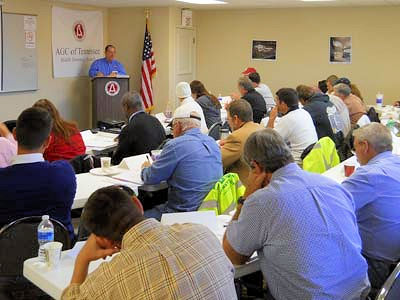18.H.04 Training.
Members of drilling crews must be provided training based on the equipment operating manual and the AHA. This training must include, at a minimum:
- The operation, inspection, and maintenance of the equipment;
- The safety features and procedures to be used during operation, inspection, and maintenance of the equipment; and
- Overhead electrical line and underground hazards.
- Only one emergency shutdown switch is required on a pier-hole rig.
- Rigs must be shut down before any helpers enter a barricaded area.
- Auger heads must be in the hole or a cover placed over the hole before workers enter the barricaded area.
Note: If infeasible due to type of drill equipment being used, a risk assessment must be performed by a Competent Person (CP), and documented in the AHA as to why this requirement is not practical. Identification of additional precautions and/or controls must be identified to insure an equal level of safety is being accomplished.
18.H.06 Clearance from electrical sources must be as specified in Table 11-1.
- Drilling equipment must be posted with signs warning the operator of electrical hazards.
- The equipment operator must assure proper clearance before moving equipment. Clearance must be monitored by a spotter or by an electrical proximity warning device.
| Voltage (nominal, kV, alternating current) |
Minimum clearance distance |
|---|---|
| Up to 50 | 10 ft (3 m) |
| 51 – 200 | 15 ft (4.6 m) |
| 201 – 350 | 20 ft (6 m) |
| 351 – 500 | 25 ft (7.6 m) |
| 501 – 750 | 35 ft (10.7 m) |
| 751 – 1000 | 45 ft (13.7 m) |
| Over 1,000 | (As established by the utility owner/operator or registered professional engineer who is a qualified person with respect to electrical power transmission and distribution) |
Note: All dimensions are distances from live part to equipment and components at any potential reach.
18.H.07 Moving equipment.
- Before drilling equipment is moved, the travel route must be surveyed for overhead and terrain hazards, particularly overhead electrical hazards.
- Earth drilling equipment must not be transported with the mast up. The exception is movement of the equipment required in drilling a series of holes, such as in blasting, if the following conditions are satisfied:
- (1) Movement is over level, smooth terrain;
- (2) The path of travel has been inspected for stability and the absence of holes, other ground hazards, and electrical hazards;
- (3) The travel distance is limited to short, safe distances; and
- (4) Travel with mast up may only be performed according to manufacturer's recommendations and/or specification.
18.H.08 Equipment set-up.
- Equipment must be set-up on stable ground and maintained level. Cribbing must be used when necessary.
- Outriggers must be extended per the manufacturer's specifications.
- When drilling equipment is operated in areas with the potential for classification as a confined space, the requirements of Section 34 must be followed.
18.H.09 When drilling equipment is parked or disabled on a highway or the adjacent shoulder, yellow flashing lights and other traffic warning devices (cones, flags, signs, etc) per 49 CFR 571.5 must be used during the daytime and reflector, flares, electric lights or other effective means of identification must be displayed at night.
Knowledge Check Choose the best answer for the question.
18-12. Who will have control of drilling equipment emergency shutdown devices?
You forgot to answer the question!

